About Rangelands monitoring
Rangelands monitoring is the process of periodically recording the condition of the natural resource including vegetation, water, and soil. Over time, change in the pasture composition and consequently general land condition can be assessed. This information can assist land management decisions to ensure sustainability of the pastoral enterprise without any long term deterioration in pastoral land condition.
The monitoring program in the NT was implemented in 1993 with the introduction of the Pastoral Land Act and through recommendations from the Pastoral Land Board.
The key elements of the Pastoral Land Monitoring Program include:
- to provide for the monitoring of pastoral land so as to detect and assess any change in its condition
- to gain an understanding of landscape processes and the impact the Pastoral industry has on the land resources
- periodic documentation and recording using photography, data on plant composition, species present, domestic stocking rates, current and historical total grazing pressure (including feral/native herbivores), rainfall, seasonal conditions and pasture conditions
- interpretation of reasons for change such as seasonal conditions, fire, grazing management, stock numbers, presence of feral animals
- consideration of paddock management strategies used in the past and adjustment of management as required
- using remote sensing techniques to assess broadscale and site specific change.
The Pastoral Land Board is also responsible for approving the clearing of native vegetation on pastoral properties.
The Pastoral Land Board has published revised Guidelines for Clearing Pastoral Land that are consistent with the native vegetation clearing controls introduced under the Planning Act.
The current guidelines outline changes to the procedures for assessing and approving clearing applications on pastoral land. This includes a requirement for preparation of a property management plan for land clearing development, public notification processes inviting submissions on pastoral land clearing applications and a register of determinations to be available for public viewing.
Monitoring
Monitoring and reporting on the condition of pastoral land is a key function of the Pastoral Land Board which is also responsible for instigating remedial action to restore pastoral land condition. The Pastoral Land Board is required to report to the minister annually on the general condition of pastoral land.
Go to the Pastoral Land Board Annual Reports.
In support of the Pastoral Land Board, the department operates a two-tiered pastoral land monitoring system.
The Tier 1 program uses photos and visual assessment of photo-point sites to assess pastoral land condition and changes over time. Pastoralists are encouraged to use the photo-point sites to become more aware of pasture plants and the level of pasture used by stock.
Properties are visited every three years under the Tier 1 program. There are 2,235 Tier 1 sites established throughout the Territory on 223 properties (including some on other tenures that are also used for pastoral production such as crown leases and Aboriginal properties), with an average of 10 sites on each property.
The Tier 2 programs are designed to provide an objective assessment of pastoral land condition using remote sensing and ground-based assessment. The program aims to distinguish between changes in pasture resulting from season from those due to grazing management over time.
Why pastoral land is monitored
Pastoral land requires monitoring to:
- assess the response to management decisions and improve future decision making
- demonstrate that ecologically sustainable land care and management practices are in place
- show changes in pasture composition, determine pasture condition and trend
- improve prospects to obtain sustainable production
- improve knowledge of plant species and plant communities eg, desirable and less desirable plants and increaser and decreaser species
- provide knowledge of plant ecology under grazing
- record photographically the condition of the land over time
- produce records of seasonal conditions and paddock management
- as a management tool providing a basis to assist with decisions such as:
- placement of new watering points, use of pipelines
- location of new fences and relocation of old fences
- locating roads and tracks
- increasing or decreasing stocking rates
- introducing rotational grazing
- spelling paddocks to allow seed set
- burning to control juvenile woody weeds
- reclamation, reseeding, remedial works
- responsible land clearing.
Pastoralist involvement: a key ingredient
Property owners and managers will gain the benefits of monitoring activities conducted on their properties by being involved and committed to the program.
The benefits centre on having better information for maintaining and ideally improving pasture productivity as well as complying with the requirements of the Pastoral Land Act in maintaining land condition.
Pastoralists review their pasture resource every time they check their stock’s watering points. They gamble every day against the weather and the markets. They make critical decisions on almost a daily basis about the welfare of both their stock and the natural resource they rely upon for their business.
If the resource is degraded by overstocking over a long period of time, the pastoralist has defeated his purpose of having a sustainable business. The loss of perennial pasture leads to increased soil erosion, woody weed infestation and more pressure on the grazed resource.
The landholder and manager know their land systems, livestock behaviour and management practices on their property better than anyone else.
They are also privy to the favoured grazing areas of cattle and thus are in a position to ensure the native pasture is not over-utilised to the point of degradation.
They are also in the best position to help Rangelands Monitoring Officers choose appropriate monitoring sites as well as observe and interpret the reasons for any change in pasture condition.
Tier 1 monitoring system
The Tier 1 Monitoring System (or Photopoint System) is an on-ground monitoring program and aims to help pastoralists with management decisions by recording changes at specific pasture sites over time.
These sites, known as monitoring sites, are established by Rangeland Officers of the Department of Land, Planning and Environment in association with property lessees.
The Northern Territory (NT) has been divided into pastoral districts. View the NT pastoral districts PDF (850.5 KB).
Properties in these pastoral districts are monitored by Rangelands Monitoring Officers based in Darwin, Katherine and Alice Springs.
District | Area (km) | Number of monitoring sites |
|---|---|---|
Darwin | 37103 | 141 |
Katherine | 19333 | 49 |
Victoria River District (VRD) | 134577 | 329 |
Roper | 42040 | 81 |
Stuart Plateau | 43104 | 179 |
Gulf | 92607 | 113 |
Barkly | 133447 | 439 |
Tennant Creek | 69188 | 80 |
Plenty | 54252 | 157 |
North Alice Springs | 102612 | 323 |
South Alice Springs | 92939 | 265 |
Monitoring sites are selected with a view to satisfying three levels of assessment at various scales:
- the pastoral based assessment
- advisory agencies’ assessment
- land administrative agency’s assessment.
Goal
The goal of this program is the achievement of sustainable use of pastoral lands in the NT through prevention of land degradation and ensure regeneration activities are implemented when required.
Aim
The aim of the program is to provide objective information that will:
- assist pastoralists in the management of rangeland resources
- provide information to pastoralists’, land administration agencies and wider community about changes to rangeland resources
- enhance understanding of the response of rangelands to climatic, seasonal and management – related impacts.
Objective
The monitoring program objective is to:
- encourage adoption of appropriate management practices to ensure the sustainability of the natural resource and provide intergenerational equity
- assess range condition and trend
- interpret trends and the implications for productivity and management
- involve pastoralists, thus ensuring credibility and acceptance of monitoring by industry and increase landholders awareness and understanding of monitoring techniques and data
- provide information with potential to be incorporated into remote sensing techniques.
Method
Monitoring sites comprise two steel pickets located 10 metres apart, set in pasture types preferred by stock, about three to four kilometres from stock water and easily accessible from station tracks or fence lines.
A photograph is taken at the site from the sighting picket looking towards the central (tagged) picket. When establishing the sites, Rangeland Officers also list the plant species present and assess the relative proportion of major species, within a 50 metre radius of the central (tagged) picket.
On future visits, Rangeland Officers list the plant species and the percentage cover on the site and make comparisons to past inspections. Erosion of the soil, type and severity, is also noted and compared with earlier visits.
Data
The information gathered includes
- the date of the visit
- location of site using a Global Positioning System
- general description of the site – such as black soil plain, tall open woodland with grassy understorey, etc.
- percentage of sand gravel and rock present (visual estimation)
- site’s location in the landscape eg: crest, upper slope, mid slope, flat, stream channel etc
- land system – type or unit if available
- colour of soil (wet and dry)
- colour of rock (wet and dry)
- fire – time of year fire went through area, intensity, frequency
- number of pasture species grazed by herbivores
- utilisation – cattle activity
- total grazing pressure on the resource – taking into consideration
- the number of cattle
- feral animals such as camels, donkeys, horses, rabbits
- native species present including termites and kangaroos.
- vegetation information – using recorded measurements of ground cover, trees, and shrubs gathered by using one square metre quadrats at 5m intervals along a 60m transect from the photograph site picket
- other information gathered will include an estimated percentage of bare ground, organic litter such as fallen leaves and seed, and an estimation of rock covering the site
- tree density and the number and heights of shrubs within the transect.
All of the information gathered at each site is entered into a central database along with the photographs of each site so reports can be created at regular intervals for the Pastoral Land Board and for the lessees.
Pastoralists are encouraged to revisit their property’s monitoring sites every 12 months or after a significant climatic event (eg rain, drought, fire) to re-photograph the sites and complete site data sheets.
Before and after scenario photographs are very useful records, and pastoralists are often in the best position to photograph these situations. Some pastoralists are already photographing their sites every six months.
These records help take the guesswork out of remembering how the country used to be. They provide a visual and written record of pastoral and seasonal conditions, paddock management, weed encroachment, and soil disturbance.
Pastoralists can then compare photos and records showing pasture condition with weather patterns and stocking levels. Officers of the Department of Lands, Planning and Environment also carry out a re-assessment of the sites and a general overview each property every two to three years.
Many of the current monitoring sites were first established by various NT Government departments, CSIRO, and commissioned consultants.
These particular sites provide a lengthy pictorial and written history of the changes in pasture composition. Some sites were first established during the drought in the early 1960s.
Other sites were established before the big rainfall events in the early 1970s and provide valuable information on change such as woody shrub encroachment of some open country.
Tier 2 monitoring system
The Tier 2 monitoring system uses remote sensing data such as satellite imagery and aerial photography to monitor changes in land condition over time.
Permanent field sites provide ground-based data that is used to verify information derived from interpretation of the remote sensing data.
Objectives
The objectives for the Tier 2 monitoring include:
- reporting on the condition of pastoral land
The Tier 2 monitoring program provides scientific data on the trend and condition of pastoral lands at a regional scale (eg: Pastoral District). This information allows the Pastoral Land Board to report on and make recommendations relating to the condition of pastoral lands to the minister responsible for the environment with the ultimate aim of achieving sustainable land use.
- regional monitoring and condition assessment of all land resources in the Northern Territory
Systems using remotely sensed data such as satellite imagery with monitoring sites and ground-truthing to report on land cover change over all lands in the Territory are currently being developed by the Department of Lands, Planning and Environment. Current rangeland monitoring techniques are being extended to all pastoral land in the Northern Territory and the use of comparable methods for determining rates of tree clearance and monitoring wetland, mangrove and coastal environments has commenced. This information will contribute to State of the Environment reporting in the Northern Territory.
- establishing a land resource monitoring database
Objective detailed scientific information on range condition at permanent sites augments interpretation of remotely sensed data and provides a basis for interpreting change. The Tier 2 database forms a benchmark for future monitoring and research and as the basis for understanding long-term change.
- establishment of Tier 2 sites to provide the following data:
- a photographic record
- vegetation abundance and species list
- soil and landform attributes
- landscape function analysis
- estimates of pasture utilisation and fire frequency.
Establishment in the tropical savannas
Tier 2 monitoring activity has focused on the pastorally productive Victoria River District with recent application in the Sturt Plateau Region.
Landscape Cover Change Analysis (LCCA) was developed over a period of five years from 1994 to 1999 where relationships between ground-based sites and time-series Landsat data were established.
A total of 69 Tier 2 ground based sites have been installed on seven leases in the Victoria River District (VRD) and a further 24 sites installed on six leases in the adjacent Sturt Plateau region in 2000.
Regional land condition assessment over a four-scene Landsat mosaic covering 66,550 square kilometres was completed as part of the National Land and Water Resources Audit (Karfs et al. 2000). A monitoring database established for the VRD is now operational and will be included within the NT Government Natural Resource Information Management Environment (NRIME). The VRD database is the prototype for Tier 2 monitoring information though modifications are anticipated in other regions of the NT due to climatic and environmental differences.
Tropical savannas
Landscape Cover Change Analysis (LCCA) involves the integration of time-series Landsat satellite data with ground monitoring, land resource and infrastructure spatial datasets.
Detailed information of on-ground measurements is enhanced by the extrapolative capacity of remote sensing. Both ground sites and satellite imagery have a specific purpose and compliment the others limitations.
Ground sites provide a detailed measure of on-ground processes and a description of what occurs at that point in the landscape.
This data is useful for understanding the ecology of the landscape, describing the biodiversity, and interpreting time-series satellite imagery.
Also long-term field studies will explain seasonal trends or disturbance-induced changes. However, site data is limited in its capacity for extrapolation, which is where the remote sensing comes to the fore.
The advantage of satellite imagery is its ability to assess cover over broad scales. Landsat MSS and TM data are used for mapping differing responses associated with land condition.
Time trends based on historical satellite information are produced and validated with the ground site data. The imagery is acquired in the late dry season, when most of the vegetation cover is senescent.
Site size and layout

The sites are 100m x 100m (1 hectare) square, except for the first 14 Tier 2 monitoring sites established on Victoria River Downs (150m x 150m).
This smaller size increases efficiency during assessment of the site, such as reduced distance to walk and ease of location of corner pickets. 100m is equal to the standard tape size and transect length for Landscape Function Analysis (LFA).
All sites are orientated down slope between pickets 1 to 2 and pickets 3 to 4. A theodolite is used to determine the maximum slope and survey in the permanent corner pickets and centre picket.
Site pickets are labelled with aluminium tags on which site information and picket number are stamped.
Each picket is painted white with the top 30cm sprayed red to assist in relocating the pickets.
An additional roadside picket (or several fence line pickets) are similarly painted and labelled to facilitate relocating the site along the road and remind managers and station workers of the site location.
Roadside pickets are labelled with a tag containing the site distance and direction from the road. Additional information useful for relocation is distance from nearest landmark and direction, which is recorded on site sheets and in the database for later reference.
Site photography
For a Tier 2 Monitoring site the photo is taken at 180 degrees, to have the sun shining on the vegetation and behind the lens.
The photographer stands on a 1.2m ladder behind the centre picket, looking away from the permanent centre picket toward a temporary picket 10m away.
A white board with site number and date is hung on the temporary picket. The temporary photo picket is used because cattle have been known to selectively graze and trample the grass around permanent pickets leaving a disturbed or bare patch.
Southern region of the NT
Currently, the southern region of the NT is being monitored using a different technique.
Remote-sensing-based-monitoring (RSBM), by its nature, identifies areas with the highest potential for land degradation. Basic processing and analysis of satellite imagery can indicate sites requiring either amelioration or at least on-ground assessment.
The cattle management features that are most readily observed on the satellite imagery are of two types:
- numerous, wide cattle pads radiating from watering points
- inter-paddock differences in grazing pressure - sometimes both overlap.
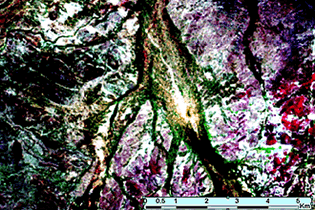
An example of cattle pads radiating from a bore as seen in a Landsat image.
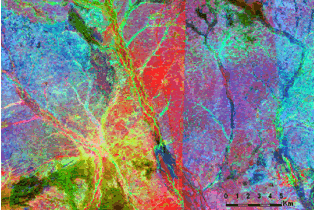
An inter-paddock fence difference, shown in the processed Landsat image above: bare ground in red, fresh vegetation in green and old vegetation in blue.
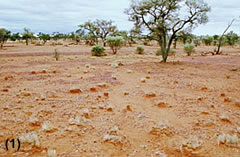
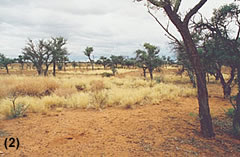
The same inter-paddock difference corresponding to the red versus blue difference in the processed Landsat image above but seen on the ground. On the left (1), grass and pedestalling of individual grass clumps due to erosion, and on the right (2), older grass and soil surface intact.
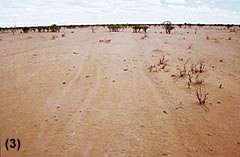
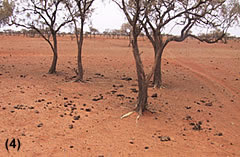
Closer to the bore bare topsoil is seen on imagery as highly reflective areas (usually white) and in these areas erosion is usually even more severe, e.g. loss of topsoil. In the photograph above left (3) 1km away from the watering point – sand drifts across adjacent cattle pads: and right (4) 500m away from the watering point – tree roots are bared by loss of topsoil.
More quantitative processing of imagery can reveal the spatial extent and degree of loss in vegetative biomass, compared with surrounding areas. Sometimes however the change in fresh vegetation in degraded areas is the reverse of that expected, therefore a range of environmental factors must be considered during analysis of the quantitative results.
The grazing gradient graphs below show soil bareness as a function of distance from water of two different degraded areas. The information was retrieved from processed Landsat imagery and ASTER imagery using Geographic Information System (GIS) computer software.

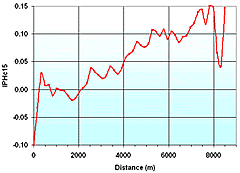
The one on the left has decreasing bareness (with increasing vegetation) with increasing distance from water, and the one on the right has increasing bareness (with decreasing vegetation).
The gradient in the graph on the left was due to more senescent (old) grass being consumed closer to the bore.
The gradient in the graph on the right was because rain caused abundant fresh grass growth on bare ground closer to the bore. A mixture of gradients can appear on one graph, thus making a quantitative value of degradation impossible.
There are limits to the applicability of RSBM because:
- satellite imagery shows indicators of erosion, e.g. riparian erosion, but not the erosion itself
- a high contrast between degraded and non-degraded areas is needed, either spatially or temporarily. Degraded areas with natural looking patterns are difficult to discern spatially
- imagery does not highlight historically heavily-grazed piospheres, which have been lightly grazed in recent decades, but nevertheless have a degraded seedbank
- older imagery is frequently used and management patterns may have since changed. This especially influences observations relating to inter-paddock differences
- flora biodiversity can not be assessed without using hyper-spectral imagery and investing in on-ground work to acquire a spectral library (which is very expensive).
Give feedback about this page.
Share this page:
URL copied!